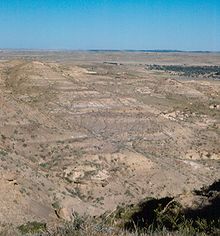Lance formation

The Lance Formation is a lithostratigraphic formation in Wyoming, United States . The formation dates to the late Upper Cretaceous (late Maastrichtian ), i.e. it was formed immediately before the Cretaceous-Paleogene mass extinction 66 million years ago. The sedimentary rocks of this formation contain one of the best known Upper Cretaceous fauna. The formation is particularly famous for its dinosaur fossils, which include well-known genera such as Triceratops , Edmontosaurus and Tyrannosaurus .
Structure and lithology
The Lance Formation spans much of Wyoming. Their sediments, some of which are more than 750 meters thick, were deposited within approx. 1.5 million years. The formation is named after the village of Lance Creek in Niobrara County .
The sediments of the Lance Formation were deposited on the edge of the Western Interior Seaway , a shallow sea that stretched in the center of North America at that time. During the deposition, there was a regression (the gradual regression ) of this sea. The dominant rocks are sandstones , pelites and marls , which formed within flood plains near the coast. In the lower sections of the formation there are marine sandstones and clay slate .
History and fossils
The importance of the formation lies in its wealth of fossils. The importance of this site first became apparent in 1872 when Fielding Bradford Meek and Henry Martyn Bannister discovered a fragmentary dinosaur skeleton in western Wyoming. The formation achieved fame through John Bell Hatcher , who, on behalf of the paleontologist Othniel Charles Marsh, collected numerous vertebrate fossils between 1889 and 1894, including fossils of the horned dinosaur Triceratops . Marsh named the fossil-rich layers Ceratops beds ( Ceratops layers), named after the then valid Ceratopsia genus of Ceratops although Triceratops was the species most commonly found. The formation was also known as Laramie beds (Laramie layers). By 1994, hundreds of Triceratops fossils were discovered in the core area of the formation in east-central Wyoming alone, including at least 100 skulls. Significant finds include two dinosaur mummies (the Trachodon mummy from 1908 and the Senckenberg mummy from 1910). Because of the constant erosion of the rocks exposed on the surface of the terrain, new finds are still regularly made today.
The formation's vertebrate fauna includes fish, amphibians, champsosaurs , turtles, scallop reptiles , crocodiles, pterosaurs , dinosaurs (including birds), and mammals. Dinosaurs are represented, for example, by the horned dinosaurs Triceratops and Torosaurus , the ornithopods Thescelosaurus , Edmontosaurus , the ankylosaurs Ankylosaurus and Edmontonia , the major theropod Tyrannosaurus , and the smaller theropods Ornithomimus , Troodon and Dromaeosaurus . A very similar fossil fauna is found in the Hell Creek Formation .
Individual evidence
- ↑ a b c d e f Brent H. Breithaupt: Lance Formation . In: PJ Currie and K. Padian (Eds.): Encyclopedia of dinosaurs . Academic Press, San Diego 1997, pp. 394-395 .
- ^ A b Richard Swann Lull, Nelda E. Wright: Hadrosaurian Dinosaurs of North America . In: Geological Society of America Special Papers . No. 40 , 1942, pp. 13 .